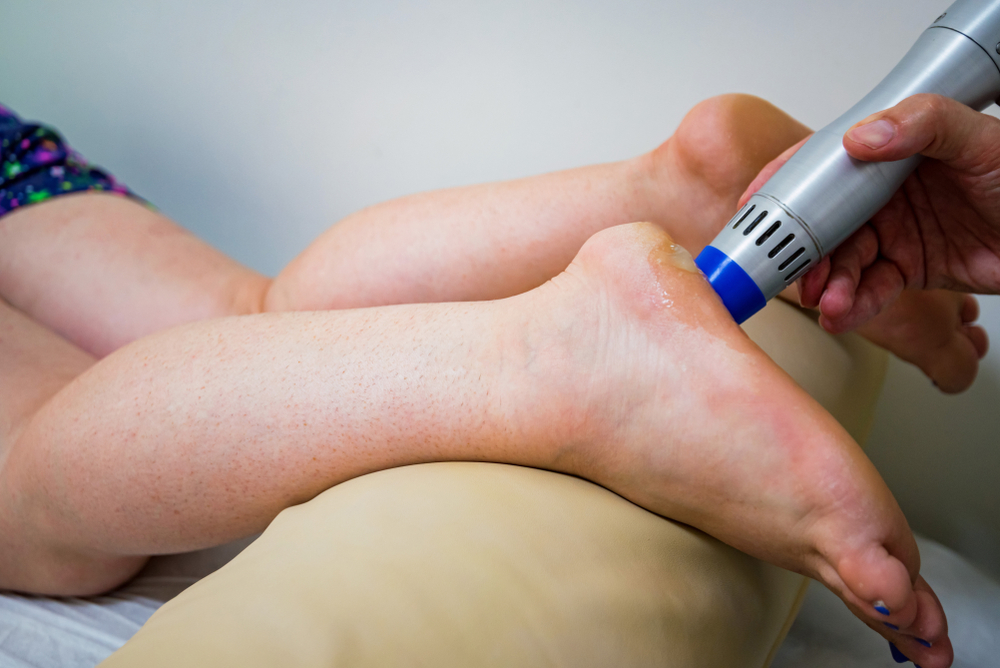Therapeutic shockwaves were introduced over 20 years ago as a medical treatment for eliminating kidney stones without causing skin injury. Some of the side effects discovered while using this treatment were accelerated bone and soft tissue healing on the areas submitted to shockwave treatment.
What makes shockwave therapy unique to the treatment of musculoskeletal disorders is that it is one of the very few technologies that seems work best when an injury reaches the chronic, non-healing state. When this occurs, shockwave therapy appears to be able to jump start the healing process in chronic, non-healing injuries and move them back into the acute phase of healing. It does this by stimulating increased cellular activity of the injured tissue to repair and heal. The acoustic vibrations also mechanically stimulate the area which has been scientifically proven to assist breaking down calcifications.
In addition, by hyper stimulating nerve endings there is an immediate reduction in pain and tissue sensitivity. The formation of new nerve and blood flow to the injured area also found with the use of radial shockwave assists with the healing and tissue regeneration process. More recently, it has been found that Radial Shockwave can be effective for releasing trigger points in muscles. Overall, Radial Shockwave can assist the body’s natural healing ability. The bodies natural repair processes can then take over and repair the area that has been damaged.
Radial shockwave therapy (RSWT) uses a pneumatic generator to produce high pressure acoustic waves that are physically delivered to the skin and underlying soft tissues. It is perhaps most analogous to having a tiny pneumatic jackhammer striking the skin to create the shockwave.
What to expect during a session of Shockwave:
A typical course of Radial Shockwave Therapy (RSWT) usually requires three treatments sessions spaced one week apart for best results, however many times patients feel significant improvement of symptoms after only one session. Although RSWT can significantly reduce symptoms after only one session, it is highly recommended that a full course of treatment be completed. During treatment with RSWT, an applicator is placed by the physiotherapist onto the affected area and fine adjustments are made to assure the dose is most comfortable for the patient. To minimize transmission losses in the layer of air between the applicator and the skin, contact gel is used to conduct the acoustic wave. The device administers a preset number of pulses, or shock waves, at a low energy level, allowing for anesthesia-free treatment. A typical treatment may last five to ten minutes and may be slightly uncomfortable.
What Conditions Does Shock Wave Therapy Treat?:
- Plantar fasciitis, heel spurs/pain
- Lateral/medial epicondylitis (tennis elbow)
- Achilles tendonitis
- Patellar tendonitis
- Calcific tendonitis
- Insertional tendonitis
- Shin splints
- Iliotibial band syndrome
- Trochanteric bursitis
What to Expect After a Treatment of Shockwave?
Many clients experience a decrease in pain immediately after treatment. In some instances bruising, swelling, and on rare occasions, skin breakdown may occur. Because of the nature of shockwaves, there may be some soreness for 1-2 hours afterwards due to an inflammatory response generated in reaction to the shockwave. This is considered NORMAL and is your body’s way of healing itself and regenerating the targeted tissue. This discomfort usually subsides after a few days.
For more information on how shockwave therapy may help you, please speak a member of our health care team.

